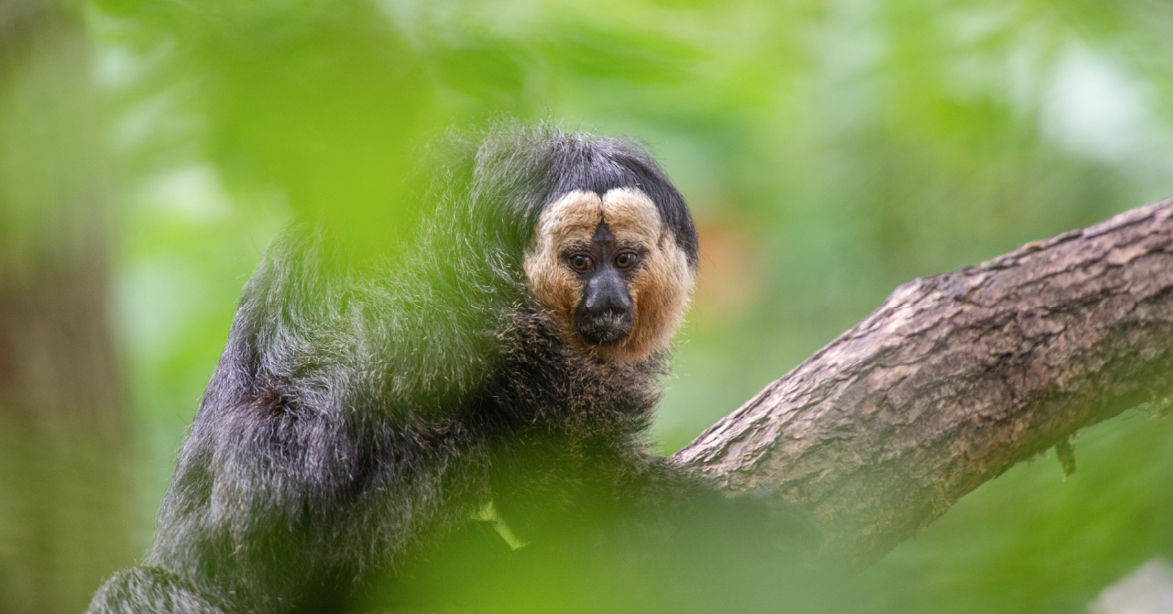White-faced saki
Pithecia pithecia
Habitat
(Rain) forests
Food
Nuts, fruits, leaves
Weight
± 1,5 kg
Age
15 to 20 years
IUCN Status
Niet bedreigd
Appearance
White-faced saki males have, as their name already indicates, white faces. However, the females do not and have a more beige/black face with orang malar (cheek) lines and greyish mottled coat. The males have a black coat. Both males and females have a thick, waterproof coat with long hairs. This coat protects them from the tropical rain showers in their wild habitat in Suriname.
Habitat
White-faced sakis live in the northern South-American countries of Suriname, French Guiana, Venezuela and Guyana. Their habitat consists of tropical rain-, mature-, swamp- and secondary forests.
Lifestyle
Sakis live in small family groups. Such a group consists of a male and a female living together with their offspring. Groups with an additional male or female do exist in the wild.
Behaviour
White-faced saki can make vertical jumps. This looks incredible: with their strong legs and feet they launch themselves into the air and land gracefully on a vertical tree trunk. They can run over branches with high speed (even with their arms raised) and can dangle from their feet. White-faced sakis are relatively shy and quiet animals. However, during mating season or to guard their territory, they can make a very loud call. In case of a predator or threat, they keep still and wait for the danger to pass. White-faced sakis are diurnal and arboreal, spending more time in the lower canopy and understory compared to other sakis of their genus.

Reproduction
The birth season of white-faced sakis is between November and April. Offspring is born with the same coat colouration as the female. After several weeks the young males will start to change colour and develop their white/creme-coloured faces. Most often the female takes care of the young. In the first month, the young saki will cling to its mother in ventro-ventral position or on her thighs, but after that the female carries the young on her back. After four months the infant can walk independently, but the female will still nurture her offspring. After six months offspring are fully grown. Females become fertile after two years of age and for males this is three years. Usually the offspring will leave their natal group after three years, but in between they may have a chance to experience the birth of a sibling. This way they can learn how to take care of their own offspring from their parents. Quite useful!
Situation in the wild
At this moment, white-faced saki populations do not seem to be substantially threatened in the wild. However, there is a continuing decline of mature individuals. Little is known about their actual numbers in the wild, but threats like deforestation and illegal hunting will most probably be a problem for this species, just as this is the case for many other animal species living in their habitat.

At Apenheul
At Apenheul we house two groups of white-faced sakis. Both groups live in the free-roaming areas, and can therefore run freely among visitors. One of the groups is housed near the insect wall and the other duo near the gorilla-island.
Population management programme
Apenheul is part of the European endangered species programme (EEP) for white-faced saki’s. By working together with other zoos we ensure a genetically healthy and demographically stable population of this species is maintained in zoos.
Fun facts
- White-faced sakis have special dentition with long canines. This helps them to crack open unripe and tough fruits, like seeds and nuts.
- White-faced sakis sleep rolled up on a branch, similar to how a cat would sleep.
Want to see the White-faced sakis at Apenheul?
Get your tickets now and roam freely among the primates!

Welcome to Apenheul
Open for business events
Park open from Friday 20 March, 10.00 hour